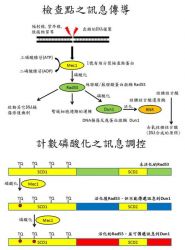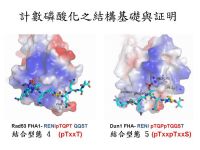Imbalance of tumor suppressor genes and oncogenes caused by gene mutations has been proven to directly contribute to tumorigenesis. The gene mutations occur due to fact that the DNA repair could not be fully completed during the cell cycle. Both DNA replication without proofreading and exogenous genomic insults such as UV light, irradiation, toxin, or carcinogen lead to gene mutations. In order to tolerate the exogenous genomic insults and ensure the fidelity of DNA replication, the cell cycle checkpoints have been evolved as mechanisms to stabilize the genomic integrity in all eukaryotic cells. Therefore, to understand how the cell cycle checkpoints are regulated is consequential to uncovering the mechanism of tumorigenesis.
A group of researchers led by Dr. Ming-Daw Tsai at the Genomics Research Center and the Institute of Biological Chemistry of Academia Sinica in Taiwan recently uncovered a breakthrough result for the mechanisms of checkpoints regulation. These research results have been highly recognized by the high impact journal, “Molecular Cell” in USA and has been published on June 20th as "Featured Article"Featured Article. This study presented biochemical, structural, mass spectrometric and genetic evidences to uncover a “phospho-counting” mechanism of protein post translational modification involved in the regulation of checkpoints signaling in response to DNA damages.

Rad53-Dun1 cascade in the checkpoint signaling
This research results majorly focuses on the regulation of DNA damage signaling in checkpoints. A cell cycle model organism of Saccharomyces Cerevisiae was used for this research. After Saccharomyces Cerevisiae cells sense the DNA damage, the damage signals were initiated by post translational modification on proteins involved in the signaling cascade. The very early signals are transmitted from Mitosis entry checkpoint protein 1 (Mec1) to downstream signaling proteins by phosphorylation on its substrates. Serine-glutamine or threonine-glutamine (SQ/TQ) motifs have been identified as the consensus phosphorylation sites of Mec1 serine/threonine protein kinase.
Serine/threonine protein kinase Rad53 is a very important DNA damage signaling protein involved in the Saccharomyces Cerevisiae cell cycle checkpoints. There are sixteen SQ/TQ motifs located on Rad53 protein kinase. And these SQ/TQ motifs of Rad53 have been proved to be phosphorylated by Mec1 protein kinase for transducing the DNA damage signal. Eight out of the sixteen SQ/TQ motifs are concentrated into two clusters and each cluster comprises four SQ/TQ motifs respectively and the two SQ/TQ clusters are named SCD1 and SCD2 (SQ/TQ cluster domain 1 and 2). The four TQ motifs of Rad53-SCD1 were implicated to regulate Rad53 and signal transducing from Rad53 to Dun1 (DNA damage response protein kinase), but with unknown molecular mechanisms. The research group led by Dr. Ming-Daw Tsai presented the biochemical, structural, mass spectrometric and genetic evidences to uncover a phospho-counting mechanism regulated the specificity of Rad53-SCD1 in the DNA damage signaling.

Structural based evdence for the mechanism of "phospho-counting" brinding
These research results uncovered a novel diversity of phosphorylation in regulating the DNA damage signaling cascade. Horizontal (Rad53-SCD1 and Rad53) and vertical (Rad53-SCD1 and downstream Dun1) signaling cascade could be regulated by a mechanism of phospho-counting on Rad53-SCD1 phosphorylation status. The novel regulating mechanism of phosphorylation in response to DNA damage initiated a new milestone for the basic study of cancer biology.
The work was supported by a grant from the NHRI and by GRC. The first author of the paper is Dr. Hyun Lee, a postdoctoral fellow in Tsai’s lab from South Korea, and coauthors include Ph. D. student Eric Sheng-Wen Chen from the Institute of Biochemical Science, National Taiwan University. The work also involves collaboration with Dr. Jorg Heierhorst at the University of Melbourne, Australia. The complete title and authors of the paper are listed below:
“Di-phosphothreonine-specific interaction between SQ/TQ cluster and an FHA domain in the Rad53-Dun1 kinase cascade”. Hyun Lee, Chunhua Yuan, Andrew Hammet, Anjali Mahajan, Eric S.-W. Chen, Ming-Ru Wu, Mei-I Su, Jörg Heierhorst, Ming-Daw Tsai, Mol. Cell, Volume 30 Issue 6 June 20, 2008.

